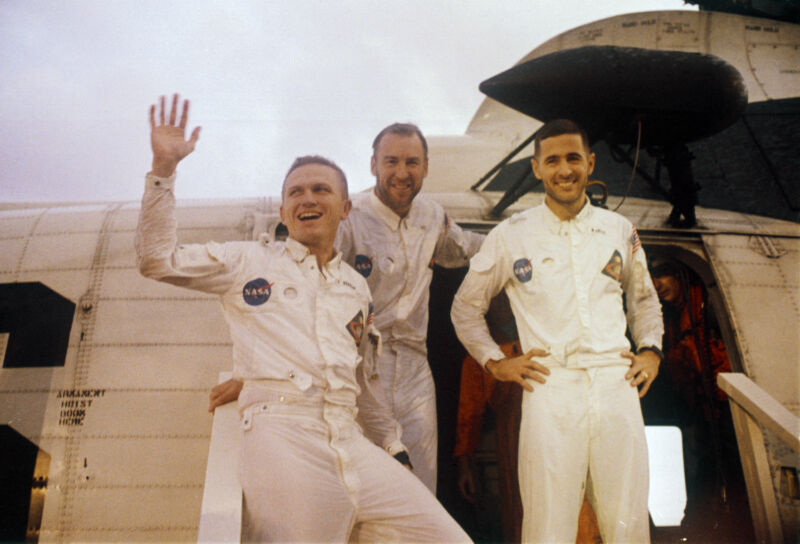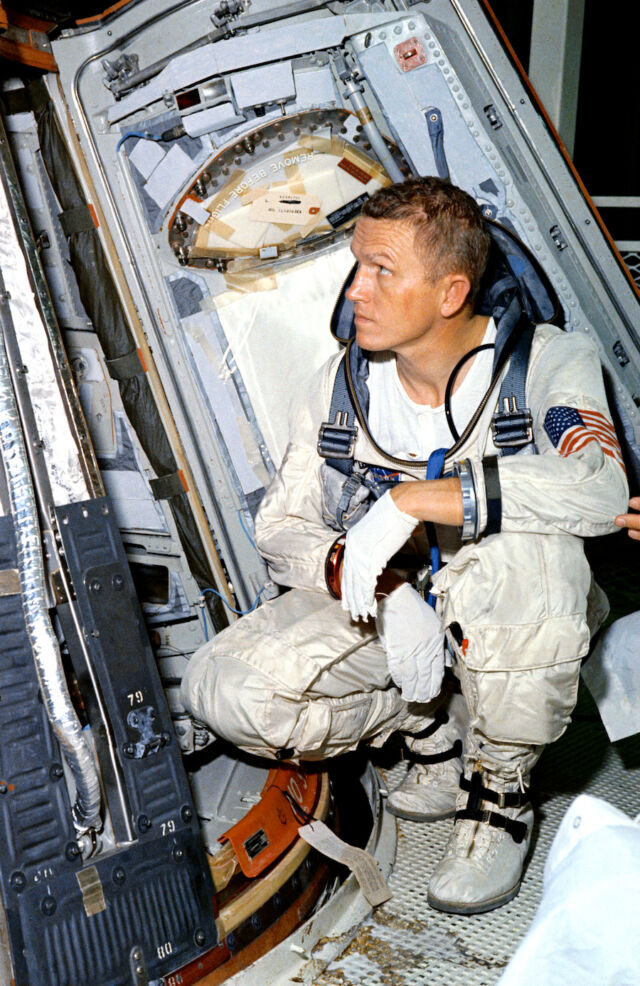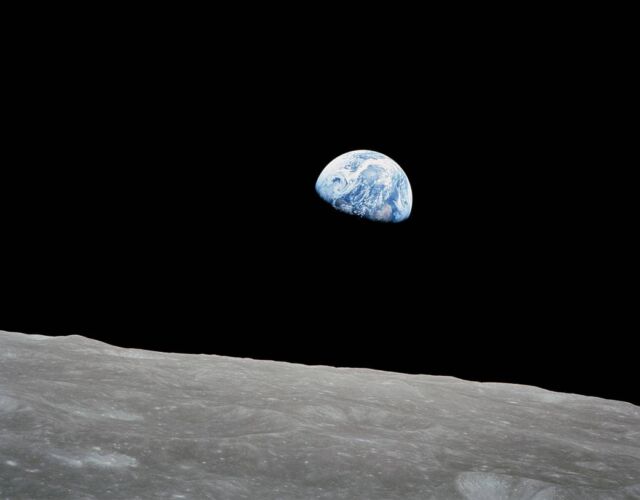
NASA astronauts Frank Borman, Jim Lovell, and Bill Anders wave to onlookers aboard the USS Yorktown after
splashdown to end the Apollo 8 mission to the Moon.
NASA/AFP via Getty Images
Frank Borman, an Air Force test pilot, astronaut, and accomplished businessman who led the first crew to fly to the Moon in 1968, died Tuesday in Montana, NASA said Thursday. He was 95 years old.
“Today we remember one of NASA’s best," NASA Administrator Bill Nelson said in a statement. "Astronaut Frank Borman was a true American hero. Among his many accomplishments, he served as the commander of the Apollo 8 mission, humanity’s first mission around the Moon in 1968."
Borman, joined by crewmates Jim Lovell and Bill Anders, orbited the Moon 10 times over the course of about 20 hours. They were the first people to see the Earth from another world, a memory of "wonderment" Borman recalled decades later. Apollo 8 produced one of the most famous photos ever taken, the iconic "Earthrise" showing a blue orb—the setting for all of human history until then—suspended in the blackness of space over the charcoal gray of the Moon's cratered surface.
"The Earth looked so lonely in the Universe," Borman said in a NASA oral history. "It's the only thing with colour. All of our emotions were focused back there with our families as well, so that was the most emotional part of the flight for me."
Frank Borman, cold warrior
Borman was born in Gary, Indiana, on March 14, 1928, and raised in Tucson, Arizona. He learned to fly airplanes as a teenager, then attended the US Military Academy at West Point before earning his commission in the Air Force to start training as a fighter pilot. Following a similar career path to that of other early astronauts, Borman became an experimental test pilot, receiving a master's degree in aeronautical engineering from Caltech, and served a stint as an assistant professor at West Point.
NASA accepted applications for a second class of astronauts in 1962 to follow the original Mercury Seven. Borman was one of the "New Nine" astronauts, and he reported for training in Houston.
Known for his no-nonsense approach to spaceflight, Borman was razor-focused on mission objectives. For Apollo 8, those were to fly to the Moon, take pictures of future Apollo landing sites, and return to Earth safely, and importantly, do it before the Russians. He didn't want to take a video camera on Apollo 8, worried that it would distract from more important tasks, but was overruled by NASA management. "I was dumb in that," Borman later admitted.
The live television broadcast from Apollo 8 on Christmas Eve became one of the most memorable moments in the history of America's space program. Borman, Lovell, and Anders read from the Book of Genesis, closing the broadcast with holiday wishes for an audience of a billion people watching on television: "From the crew of Apollo 8, we close with good night, good luck, a merry Christmas, and God bless all of you, all of you on the good Earth."
After returning from the Moon, Borman recalled the only guidance he received from Julian Scheer, a NASA public relations official, regarding what to say to people back on Earth: "Do something appropriate."
The rest was left up to Borman. He credited the wife of a friend for the advice to read from the Book of Genesis. "I thought it was wonderful," Borman said.
Borman's commentary on the Moon's appearance from an altitude of 60 nautical miles reads like a brutal description of a barren wasteland: "I know my own impression is that it’s a vast, lonely forbidding type existence, great expanse of nothing, that looks rather like clouds and clouds of pumice stone, and it certainly would not appear to be a very inviting place to live or work."
Apollo 8 was Borman's second flight into space, following a two-week flight in low-Earth orbit in 1965 on the Gemini 7 mission, the longest-duration spaceflight until that time.
NASA managers appointed Borman to the board investigating the Apollo 1 fire in 1967, which killed Gus Grissom, Ed White, and Roger Chaffee during a ground test at Cape Canaveral, Florida. Borman played a critical role in the aftermath of the tragedy, serving as the only voice for the Astronaut Office on the board of inquiry and vehemently defending the Apollo program to Congress.
These were dark times for NASA, with real risk that the agency would miss its directive from President Kennedy to land an astronaut on the Moon by the end of the 1960s. "The more we probed for answers, the more depressed the people in the investigation got," Borman later wrote. But the Moon program survived, and Borman oversaw the implementation of changes to the Apollo spacecraft at North American Aviation in Downey, California, to eliminate the problems that led to the fire.

Frank Borman looks over his Gemini 7 spacecraft.
HUM Images/Universal Images Group via Getty Images
With flights set to resume after the Apollo 1 tragedy, Borman was assigned to a mission to test the Apollo lunar module in a high orbit around Earth, part of a stepping-stone approach to prove the lander was ready to fly to the Moon. But circumstances changed in mid-1968, when the CIA reported the Soviet Union might launch a crew around the Moon by the end of the year. That would have been an embarrassment for NASA in its race with the Russians.
George Low, a high-ranking official at the space agency, suggested a change in plans. The first lunar module would not be ready for testing in space until early 1969, so in August, Low proposed sending only the Apollo command and service modules on a flight around the Moon in December.
It was a bold move. When Deke Slayton, the chief of the Astronaut Office, asked Borman if he wanted to fly Apollo 8 to the Moon, the commander didn't hesitate to sign up his crew for the mission. In the end, no Soviet cosmonauts ever flew around the Moon.
"There's no question that accelerated the emphasis on Apollo 8 going to the Moon because, in the final analysis, the Apollo program was a battle in the Cold War," Borman said. "It was a political move."
Borman, Lovell, and Anders trained for four months for the lunar mission, a compressed training schedule that required the astronauts and their support teams to work long days and weekends. Not only did the mission carry humans farther from Earth than ever before, but the astronauts became the first people to launch on top of the giant Saturn V rocket, a relatively unproven vehicle with only two test flights going into Apollo 8.
It all worked like a charm. Time magazine named the Apollo 8 astronauts their Men of the Year, and Borman traveled to Europe and the Soviet Union on publicity tours in 1969, helping plant the seed for the US-Russian partnership on the Apollo-Soyuz mission six years later. When Apollo 11 landed the first people on the Moon in July 1969, Borman was a NASA liaison at the White House. He helped persuade President Nixon not to play the "Star-Spangled Banner" or stage an over-the-top ceremony marking the landing. Instead, Nixon kept his remarks short.

The Apollo 8 astronauts were the first humans to observe an "Earthrise" from their orbit around the Moon.
NASA
With Apollo 11 in the history books, Borman moved on from NASA and retired as a colonel from the Air Force, foregoing any chance of flying to the Moon again. "I didn't care about picking up rocks or anything else," he later said with a characteristic bluntness. "I wanted to beat the Soviets to the Moon."
Michael Collins, who wrote one of the most intriguing memoirs of any of the Apollo astronauts, described Borman as "aggressive" and "capable." Borman, Collins wrote, "makes decisions faster than anyone I have ever met—with an amazingly good batting average, which would be even better if he slowed down a bit." Writing in 1974, Collins predicted Borman would be one of the most successful Apollo astronauts after leaving NASA. This projection hit the mark.
After leaving government service in 1970, Borman became an executive at Eastern Airlines, eventually becoming CEO in 1975. Borman resigned from Eastern in 1986 and served on several corporate boards late in his career. In retirement, he found new passions in ranching and rebuilding old airplanes.
Susan, his wife of 71 years, died in 2021. Before his death, Borman was the oldest living former NASA astronaut, 11 days older than Jim Lovell, his Gemini 7 and Apollo 8 crewmate, who now assumes the title.
Borman's death comes a week after that of another Apollo astronaut, Ken Mattingly, who flew in orbit around the Moon on Apollo 16 in 1972. Of the 24 people who traveled to the Moon on Apollo missions, eight are still alive: Jim Lovell, Bill Anders, Tom Stafford, Buzz Aldrin, Fred Haise, Dave Scott, Charlie Duke, and Jack Schmitt.
As the remaining members of the first generation of lunar explorers reach their late 80s and early 90s, four younger astronauts—all born after the Apollo landings—are training for NASA's Artemis II mission, which is expected to fly around the Moon in 2025. A lunar landing mission with astronauts will follow later in the 2020s. This is the closest anyone has gotten to returning to the Moon since the end of Apollo.
“Frank knew the power exploration held in uniting humanity when he said, ‘Exploration is really the essence of the human spirit,'" said Nelson, NASA's administrator. "His service to NASA and our nation will undoubtedly fuel the Artemis Generation to reach new cosmic shores."
Listing image by NASA




3175x175(CURRENT).thumb.jpg.b05acc060982b36f5891ba728e6d953c.jpg)


Recommended Comments
There are no comments to display.
Join the conversation
You can post now and register later. If you have an account, sign in now to post with your account.
Note: Your post will require moderator approval before it will be visible.